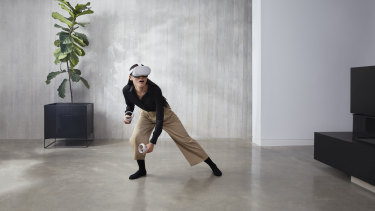
I say this having used a lot of pretty bad face computers over the past few years. Even the worst of them suggested a compelling goal. Face computers promise to improve the two things we most often do on our phones: watch stuff and take pictures of stuff. A computer you can always see paired with a camera always watching whatever you are — isn’t it obvious how such a device might fit in during the age of YouTube and TikTok?
Face computers also mitigate two of the touch-screen phone’s biggest shortcomings — the touch and the screen. My phone claims to help me, and yet it demands constant attention from my fingers and my eyes. In this economy?
This is the best pitch for the face computer: It lets you get digital information more flexibly than you can on any other device.

The Oculus Quest 2: Virtual reality will conquer gaming because it is unmatched at affecting your entire physical experience.
On the one hand, these machines can conjure experiences that are much more intense than on any other device. With a face computer, you’re not just watching videos online — you’re inhabiting them in a way that feels embodied.
Recently I’ve been hooked on Facebook’s Oculus Quest 2, the light, portable virtual-reality headset released late last year. What I like about it is its depth of experience: I’m not usually a gamer, but the Quest 2 has a large library of immersive titles that I found entrancing, among them a rock-climbing game whose perilous realism made my hands clammy.
Virtual reality will conquer gaming because it is unmatched at affecting your entire physical experience — when you ride a virtual-reality roller coster, your stomach drops just like on the real thing. Even ordinary videos gain from the VR experience — I found that scrolling through high-resolution nature videos on YouTube’s virtual-reality app is a wonderful way to remember what it was like when we were allowed to leave our houses.
To me, the stage feels set in a way that recalls the period before the iPhone’s release in 2007. Technology and consumer preferences are aligning. We’re on the cusp of something big.
Mainly we’ll use these things for fun. But there’s a chance VR catches on for other uses, too. Nutty as it sounds, I have been meditating in VR — picking some peaceful virtual spot and sitting there silently, just “feeling” the world around me. Yes, it’s super dorky; it’s also terrifically relaxing.
Computers conquered our lives during the pandemic, but it’s the rare Zoom meeting that doesn’t feel lo-fi, awkward and distant. Talking to people over VR is natural by comparison. Because the headset lets the digital world fully engulf your senses, it has the ironic effect of liberating you from the ever-present sensation that all of your interactions are being mediated by machines.
I still don’t think VR is for everyone — the experience is so immersive that it often feels impractical. VR shuts out the offline world entirely, demanding all your attention. Who has time to drop everything to climb a virtual mountain?
And so tech companies have been experimenting with less immersive machines for your face, what some call augmented reality. This is the world that Google imagined when it started selling its Glass spectacles in 2014.
As a matter of technology, Glass was a marvel — Google had stuffed a display, speakers and a camera into a machine built only slightly obtrusively into eyeglass frames. One knock on Glass was that it didn’t do a whole lot to justify its price. It could snap short videos and display digital titbits, like the weather, in the corner of your visual frame, for $US1500.
Yet function is rarely an obvious impediment in wearable tech. Wristwatches only tell time, and sunglasses only tell the world you’re awesome. In some ways not doing too much was the point of Glass. The specs promised to offer you digital information more discreetly than your phone could. It imagined a visual field one day enriched by information — the latest headlines and your incoming texts superimposed over your walk home, a cable-news chyron on the lower third of your life: SPOUSE SAYS MILK GONE. BLAME BIDEN?
The big problem with Google Glass was not technical but social. Despite the company’s best efforts to make Glass cool, the people who first got the device tended to be of a certain type — overconfident, entitled, rich tech guys. Soon they earned a derisive nickname — “glassholes” — and at that point the device was done for.
A lot has changed since Glass’ release. Cameras and mobile processors are smaller and more powerful. Now Glass-like tech can be built into spectacles without much sacrifice in style.
Loading
There is also far less social opprobrium attached to wearable tech. Earbuds and smartwatches are not just for rich nerds. And for a lot of people, especially young people, there is little separation anymore between the online world and the offline world — suggesting potentially huge demand for glasses that fix the internet to your eyeballs.
I also wonder if the pandemic might have eased people’s inhibitions about wearing something on their faces. Yes, a lot of people have recoiled at face masks, but a lot more are now quite comfortable both wearing them and seeing others wear them.
To me, the stage feels set in a way that recalls the period before the iPhone’s release in 2007. Technology and consumer preferences are aligning. We’re on the cusp of something big.
I only hope that, unlike with smartphones, this time we go slow. Smartphones became an inescapable fact of modern life long before we understood all the ways they would alter society, for better and for worse. Now, as the machines march for our faces, let’s at least keep our eyes wide open.
The New York Times
The Market Recap newsletter is a wrap of the day’s trading. Get it each weekday afternoon.



























